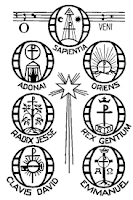As we have already noted, through the centuries, Christians have observed a time of waiting and
expectation before celebrating the birth of the Savior at Christmas. The Advent season is a time for reflection and preparation; its mood is more joyful than repentant. Our Advent celebrations have been enriched by various traditions (like the ubiquitous advent wreath) to reflect its distinctive Christian meaning. These traditions all seek to proclaim the revelation of God’s love as expressed in Christ’s birth in a humble stable, His sacrificial death on the cross, and His victorious resurrection! They point to the hope of Christ’s coming again as the King of kings and Lord of Lords. In a sense, Advent makes innkeepers out of all of us, asking each of us to make room for the arrival of the Christ Child.
Perhaps the most striking and the most universal feature of Christmas is the use of evergreens in churches and homes. Among ancient Romans evergreens were an emblem of peace, joy, and victory. Early Christians placed them in their windows to indicate that Christ had entered the home. Holly and ivy, along with pine, and fir are called evergreens because they never change color. They are ever-green, ever-alive, even in the midst of winter. Thus they can well symbolize the unchanging nature of our God, remind us of the everlasting life that is ours through Christ Jesus.
In Christian thought and sentiment, holly became widely used in church celebrations. Holly was seen to represent the burning bush from which Moses heard the voice of God, or a symbol of Mary whose being glows with the Holy Spirit. The red berries have represented the blood drops from the cruel thorns in the crown of Jesus. This latter representation is heard throughout many Advent and Christmas carols.
 And so it is that once our attention focuses on the celebration of the Incarnation at Christmas (liturgically marked on December 17, he first day for the great “O Antiphons”), we “green” our worship spaces, anticipating and “making room” for the coming of Christ on Christmas.
And so it is that once our attention focuses on the celebration of the Incarnation at Christmas (liturgically marked on December 17, he first day for the great “O Antiphons”), we “green” our worship spaces, anticipating and “making room” for the coming of Christ on Christmas.This year, our greening occurs exactly on the 17th, a great fortune of coincidence! The antiphon assigned for Evening Prayer (Vespers) on that day begin: “O Come, Thou Wisdom from on high, who orders all things mightily . . .” You might recognize this as one of the verses from the hymn “O Come, O Come, Emmanuel” (Hymnal, No. 56) and right you would be. In fact, this much beloved Advent hymn is a compilation of all seven of the “O” antiphons – one each evening from December 17th until our Christmas celebration!
Even more than the beautiful greens in our church, the Christmas tree has become the center of many of our festivities. Often glittering with lights and ornaments, it is a part of the beauty and meaning of Christmas. There are several legends and stories about the Christmas tree.
The first use of the Christmas tree was in the medieval German Paradise Plays, held outdoors and portraying the creation of humankind. The Tree of Life was a fir tree decorated with apples. Later other ornaments were hung upon them, such as paper flowers and gilded nuts. In England branches or whole trees were forced into bloom indoors for Christmas. From these beginnings the use of a tree at Christmas was established.
 The story is told that on one Christmas Eve Martin Luther wandered outdoors and was struck with the beauty of the starry sky. Its brilliance and loveliness led him to reflect on the glory of the first Christmas Eve as seen in Bethlehem’s radiant skies. Wishing to share with his family the enchantment he felt, he cut from the forest an evergreen, glistening with snow, and took it home. He placed upon it candles to represent the glorious heavens he had seen.
The story is told that on one Christmas Eve Martin Luther wandered outdoors and was struck with the beauty of the starry sky. Its brilliance and loveliness led him to reflect on the glory of the first Christmas Eve as seen in Bethlehem’s radiant skies. Wishing to share with his family the enchantment he felt, he cut from the forest an evergreen, glistening with snow, and took it home. He placed upon it candles to represent the glorious heavens he had seen. The use of a candle-lighted tree soon spread to all Europe and came to be regarded it as one of the central ornaments of Christmas.
So the next time you see the splendor of a Christmas tree, remember that it is a continuing witness to everlasting life as offered to us in Christ Jesus – and that far from a commercial enterprise, it speaks a deeply spiritual message . . . “O Christmas tree, O Christmas Tree, thy leaves are so unchanging” — Just like God’s love.
Source: Rector’s Blog

